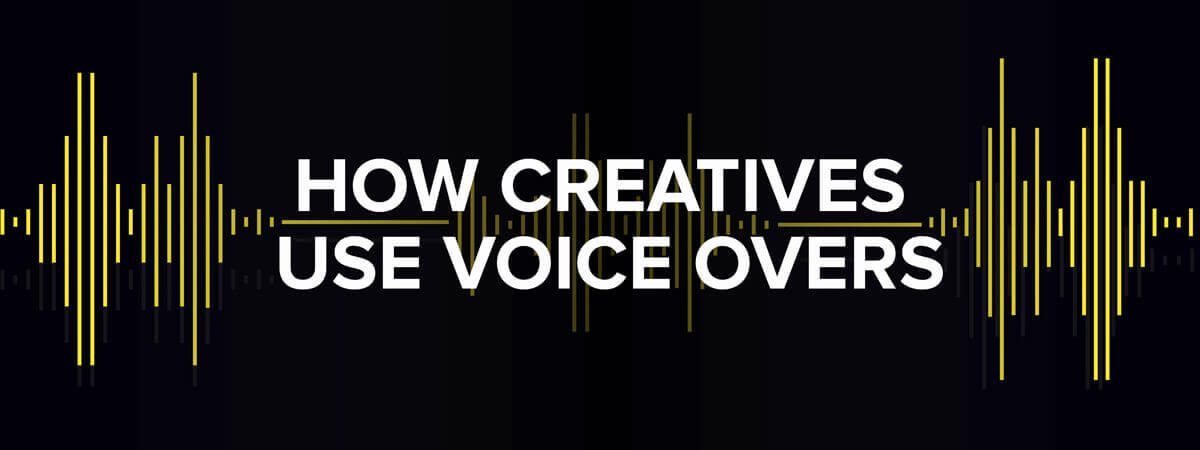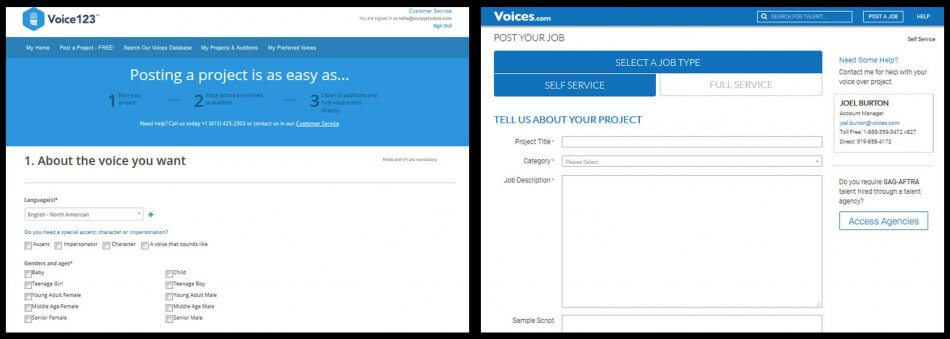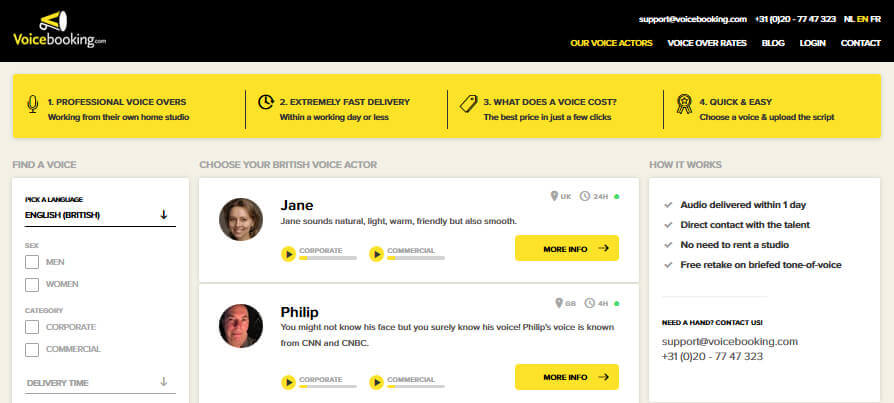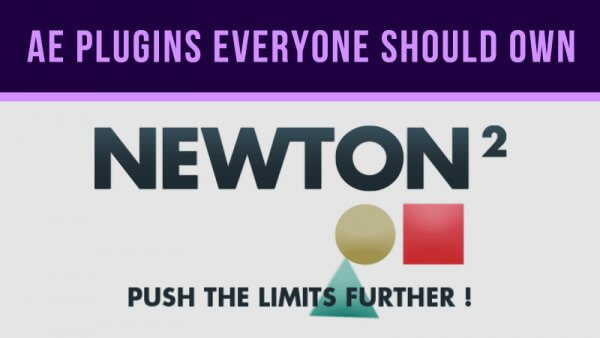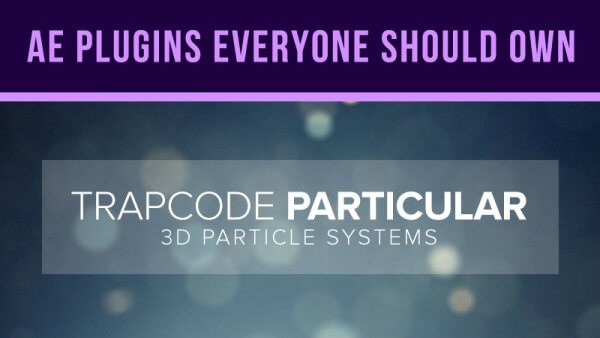A few months ago we took part in a survey for voicebooking.com about how creatives (in our case, an animation studio) use voice over artists. This led them to produce the very insightful infographic “How Creatives Use Voice Overs” that you can find below.
Inspired by this, we thought it would be interesting to write about how we work with voice artists and the different processes we use for sourcing/recording them.
The method that we use to find our perfect voice will always depend on the type of project, the budget and the schedule that we have to work with. During pre-production we will always sit down with the client and discuss what they want. We put our own thoughts and considerations across but ultimately the decision lies with them. During this stage we consider factors such as: age, sex, accent, nationality, regional, narrator vs character; plus the way we want the dialogue delivered (fun, sarcastic, confident, authoritative, etc.).
With this knowledge, we are ready to audition and record the right voice artist(s) for our project. To simplify this article, we have broken it down into the 3 most common methods that we use to find our voice artists. Lets get to it…
Method 1: Online audition platforms
Over the years, this has become our preferred method of auditioning and recording voices; we work this way for the majority of our projects now. Online audition sites let you ‘list a job’ by filling out a form listing your requirements, sample script, budget and deadline – it is a simple, quick and straight-forward way of requesting auditions – once your job has been submitted, you can sit back and wait for them to roll in. There are many of these sites out there but we have become fans of Voice123, and Voices.com.
We tend to put an audition up for 5-7 days, depending on our schedule; during which we can expect between 20-50 auditions. Once the audition is over, it is our job to listen to the custom demos that the artists have kindly recorded, which we usually then narrow down to our top 5 for the client to listen to. Most of these platforms have a neat feature that allows you to collate your favourite voices into a custom URL that you can then send to your client. Once you have selected your voice artist, it is up to you whether you want them to record in a studio or to do everything remotely. We prefer the remote option, as this also allows us to request retakes relatively easily – saving both time and money for everyone, and we can direct the performance over the phone.
Although we have successfully auditioned for character voices via these sites, we tend to find them more useful for projects that require a narrator, such as explainer or educational films. We find this method ideal for ‘single film’ projects (that are no longer than 5 minutes), as we have the flexibility to re-record and request retakes without impacting the budget and schedule too much.
Method 2: Voice agencies
On occasions, there are projects where it just doesn’t work out using the online auditioning platforms. This is usually the case when you are looking for a very specific type of voice, a child voice artist, or a professional/established actor (not a star name).
Our recent project for the Palladium boot is a case in point. As a French brand, our client wanted to use a French accent, speaking English, to narrate the film. We originally auditioned using the online platforms listed above. However, when we listened to all the auditions we found there were many English voice artists imitating French accents, and of the few authentic French artists, nothing really worked. Running out of time, our best option was to approach an agency to source the voice for us. Luckily, they sent through a few excellent options, with one stand out choice. After selecting our voice, the agency put us in direct contact with the artist and we took it from there. Again, you can chose whether you want to work remotely or in a recording studio. If the latter, then the agency can usually manage that for you, as well. Again, there are many agencies out there, but Voicebooking.com and Spotlight are two of the agency sites that we use.
We can’t speak for every agency, but from our experience there are a couple of factors to consider:
- The cost will usually be more as you are no longer just dealing with the artist; plus you are dealing with established actors or specialist voices, which command a higher fee.
- Most agencies will list their artists in an online database, and using their search filters, you can narrow it down to the ones that suit your criteria. However, you will still have to check out the artist’s individual profile/demo reel before contacting them (ie. to request a custom demo, check their availability and fees, etc.). Of course, this isn’t that much extra work, but if you have a tight schedule or want to streamline the process as much as possible, this option will be slightly more labour intensive.
It is important to note that many voice over agencies are happy to provide you with a shortlist of their own, if you send them a brief, and also have their artists do self record auditions. Agencies can definitely save you time and money, but as always, it depends on the project at hand, and your specific requirements, as to which option you choose.
So if you require the voices of children, a ‘Radio 4’ sounding narrator, or a French man speaking English, you may be best off using this method!
Method 3: Going straight to the source…
On those rare projects where you know exactly who you want to voice your film, the only option is to go straight to the source: the agent of the voice artist/actor.
This method does away with the auditioning process – after all, you or your client firmly know who you would like to voice your film. If you are in the position of knowing who you want, there is a good chance that the voice artist will be a well known voice/actor/celebrity. We have taken this approach on charity projects where the aim was to raise awareness (Voicing CSA, with Chris Harper). Plus, on our own short film the Fearsome Beastie (voiced by the wonderful Brian Blessed and Alison Steadman).
After knowing who we wanted to work with, the next step was to do some digging on Google to find out the agent or agency who represents that artist. When contacting them, we gave as much information about the project as we could, and requested the artists fees and availability. From here, it is common for there to be some back-and-forth on recording fees, usage fees, travel costs, availability dates, etc. Unlike the other two methods above, you will be required to organise the recording session yourself (studio hire and sound engineer).
Despite the convenience of online audition and recording remotely, nothing beats getting artists into a recording studio and directing them live. This would always be our preferred method, and we look forward to those projects that afford us this opportunity.
We hope you have found this article useful – if you have any further questions about how we work – whether you are looking to produce an animated film or if you are a voice artist yourself – feel free to drop us a message here!
Finally, enjoy the infographic below to find out more about how other creatives use voice over artists…
